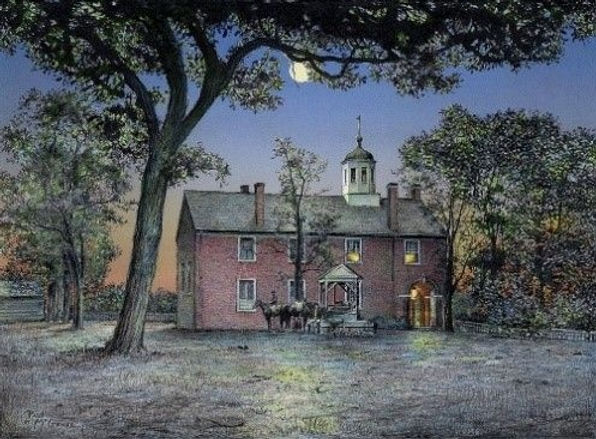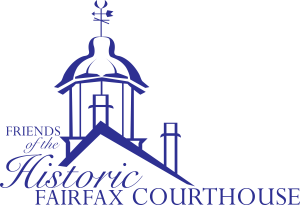
The Fairfax Courthouse would exchange hands several times throughout the Civil War. The quick-thinking and fleeing court clerk, Alfred Moss, saved the will of George Washington (in which he freed all his enslaved) and other historic papers. Moss took them on horseback by night for safekeeping into other Virginia environs. These historic papers were returned to the courthouse after the end of the war.
The old historic Fairfax Courthouse building was completed in 1800 as the seat of government for the growing county of Fairfax, Virginia, and has been the scene of many historical occurrences. The first court session held in the new building was concerning the recording of the will of George Washington’s nephew Corbin Washington. The courthouse would later hold the wills of both George and Martha Washington. Throughout the years of the early 19th century, the courthouse saw everything from county registrations, marriage licenses, property deeds, wills, court cases, polling and elections, and so on.
The courthouse grounds also became the town meeting place for fox hunts, merchants, and county fairs. These gatherings later became festive occasions known as “court days.” (In keeping with the spirit of those times, today there is a well-attended Saturday market held from May – September behind the old courthouse on West St. and Main St.)
On April 12, 1861, a new chapter unfolded for the Fairfax Courthouse as the Civil War broke out following the attack on Fort Sumter at Charleston, South Carolina. Tensions quickly mounted, and on May 23, 1861, Fairfax County residents approved the Ordinance of Secession by a vote of 945 to 289, with 11 of 14 Fairfax County precincts voting in favor. The vote at Fairfax Courthouse was overwhelmingly for secession, 151 to 8. There were reports that armed officials helped persuade some voters.
In the early hours of the morning on June 1, 1861, 210 Confederate Virginia troops camping around the courthouse grounds found themselves engaged in a surprise attack from Union Cavalry forces. The ensuing chaotic skirmish led to the first death of a Confederate officer in the Civil War, Captain John Quincy Marr, who commanded the Warrenton Rifles. The attack on Fairfax Courthouse would go down in history as one of the first land engagements of the Civil War between northern and southern forces. By July, the Confederates abandoned the area, as all eyes and manpower on both sides were focusing on the huge battle yet to come that would be called the 1st Battle of Bull Run/Manassas.
The Fairfax Courthouse would exchange hands several times throughout the Civil War. The quick-thinking and fleeing court clerk, Alfred Moss, saved the will of George Washington (in which he freed all his enslaved) and other historic papers. Moss took them on horseback by night for safekeeping into other Virginia environs. These historic papers were returned to the courthouse after the end of the war.
Unfortunately, during the Union occupation of the courthouse building, many other important documents were destroyed, often used to fuel fires. Luckily, Martha Washington’s will was found scattered on the floor and taken by a Union officer. Years later, his heir sold the historic documents to J.P. Morgan for a tidy sum of money. Her will remained in the possession of the Morgan family for many years. Eventually, it was returned to the Fairfax Courthouse, where both wills are displayed from time to time in the County Clerk’s Circuit Court Historic Records office.
Today, the old Fairfax Courthouse has been restored and is one of the oldest and most historic places in northern Virginia. Newer buildings on the grounds still serve as the Fairfax Juvenile and Domestic Relations General District Court. Cannons are in place to remind passersby of its historic past, and a monument has been erected in memory of Captain Marr (removed in 2022).
The Historical Fairfax Courthouse at 4000 Chain Bridge Road was built in 1800. It is a national landmark and was the seat of civil war activity, changing hands from Confederate control to Union control and back several times. The first officer casualty of the Civil War occurred on the grounds here. Captain John Quincy Marr was killed during a skirmish between Union cavalry and the Confederate Warrenton Rifles who were then occupying the courthouse grounds. This courthouse is still in use today and is currently the home of the Fairfax Juvenile and Domestic Relations General District Court & Clerks Office.
The Jennings Judicial Center located at 4110 Chain Bridge Road was erected in 1982 and is named after former Fairfax Circuit Court Chief Judge Barnard F. Jennings. It houses the Fairfax Circuit Court & Clerks Office, the General District Court & Clerks Office, Office of the Commonwealth’s Attorney, the Fairfax Bar Association and Law Library, and the Sheriff’s Office. The Magistrate’s office and the Adult Detention Center are connected to the Jennings building.
Fairfax County, Virginia was created in 1742 from Prince William County. When it was formed it encompassed land that is now the Counties of Loudoun, Arlington, and Fairfax, and the Cities of Alexandria, Falls Church, and Fairfax. Fairfax County was the home of George Washington, the first president of the United States. President Washington and Martha Washington’s Last Will and Testaments were probated in Fairfax and are frequently displayed in the Circuit Court Clerk’s Office at the Jennings Judicial Center.
Among the nation’s landmarks located in Fairfax County are President Washington’s Mount Vernon Estate and George Mason’s home, Gunston Hall. When Thomas Jefferson wrote the Declaration of Independence he drew from George Mason’s Virginia Declaration of Rights for the first few paragraphs. Later, when the Bill of Rights was written and added to the U.S. Constitution, it was also based upon Mason’s Virginia Declaration of Rights which was adopted by the Virginia Constitutional Convention on June 12, 1776 and ratified on Dec 15, 1776.
Today, at the cross-roads of Fairfax City and Fairfax County sits George Mason University, a prominent national university.
Fairfax, Virginia is located in the suburbs of our nation’s capital, approximately 25 miles south. Fairfax County is a large suburban area consisting of more than 960,000 residents.
